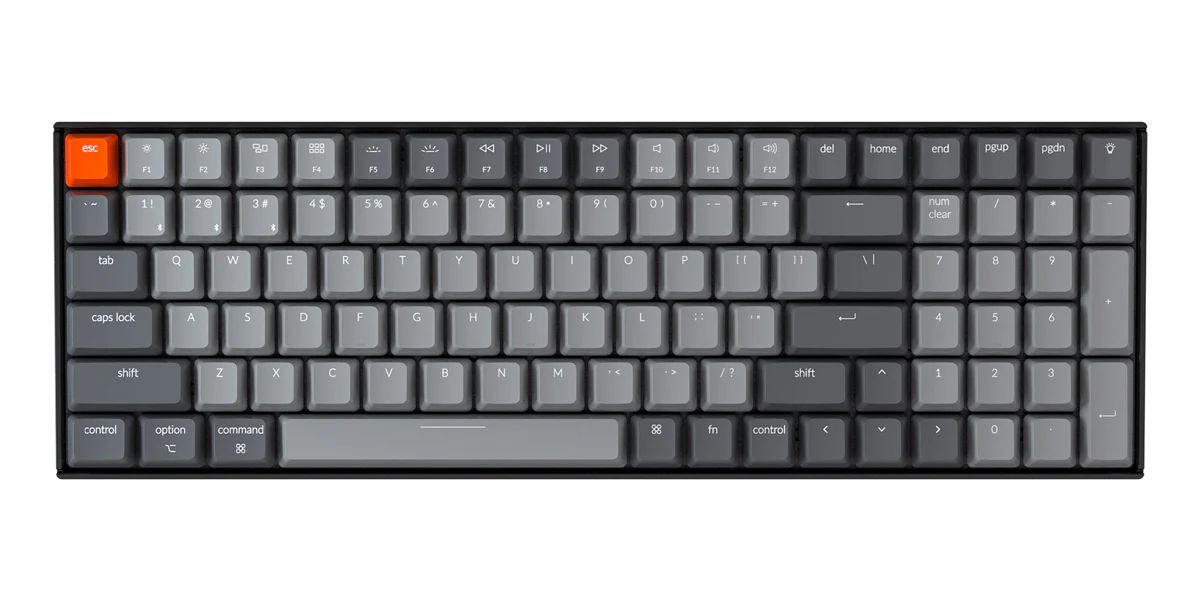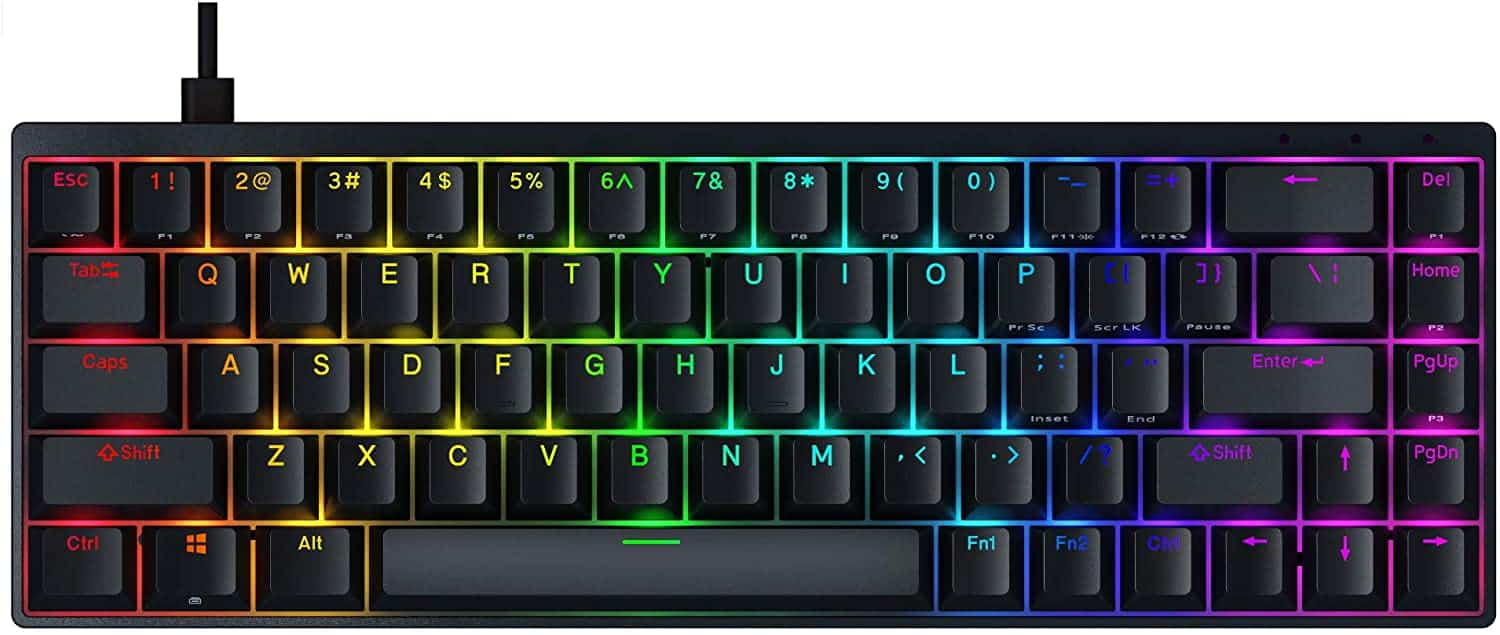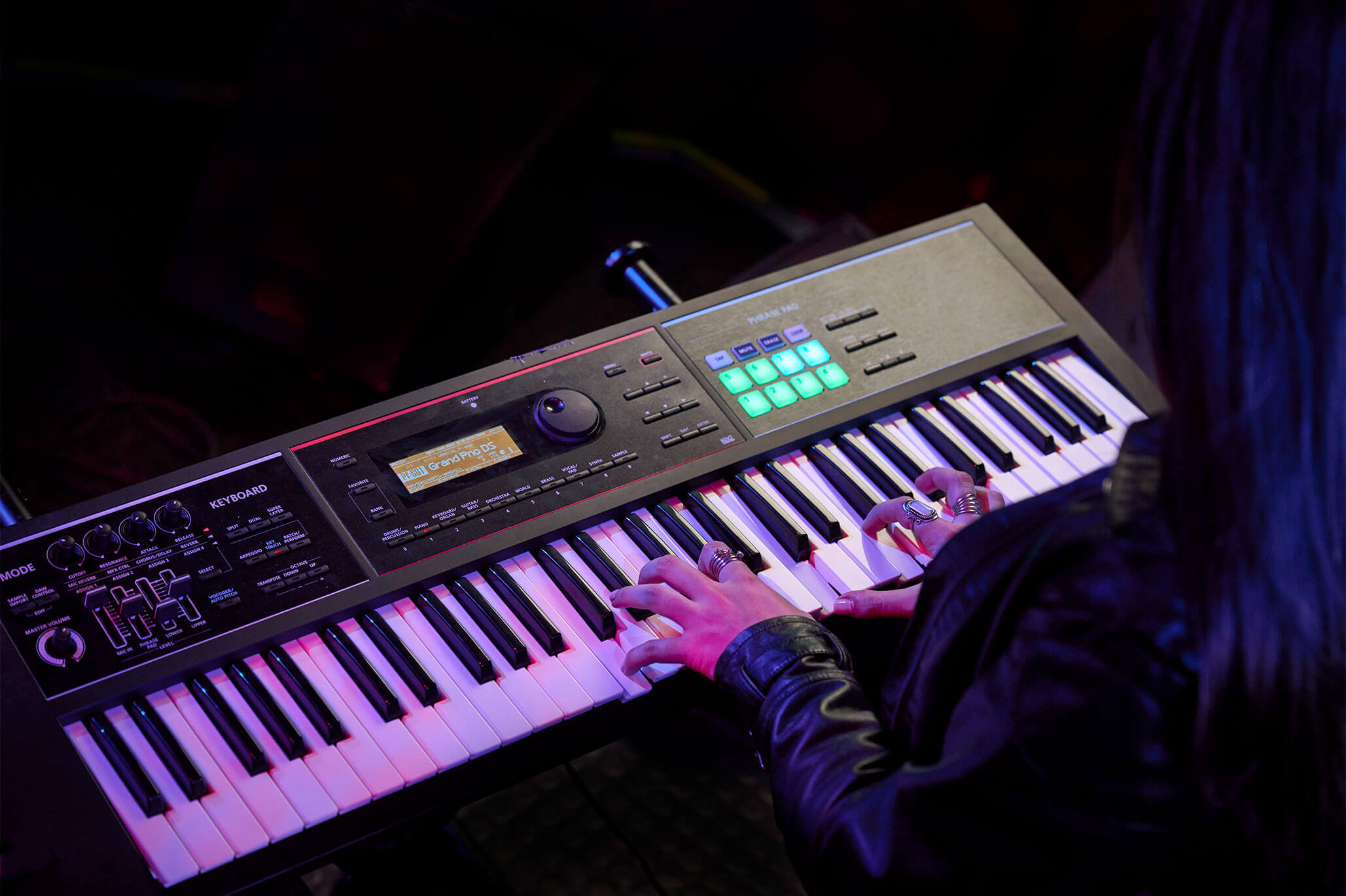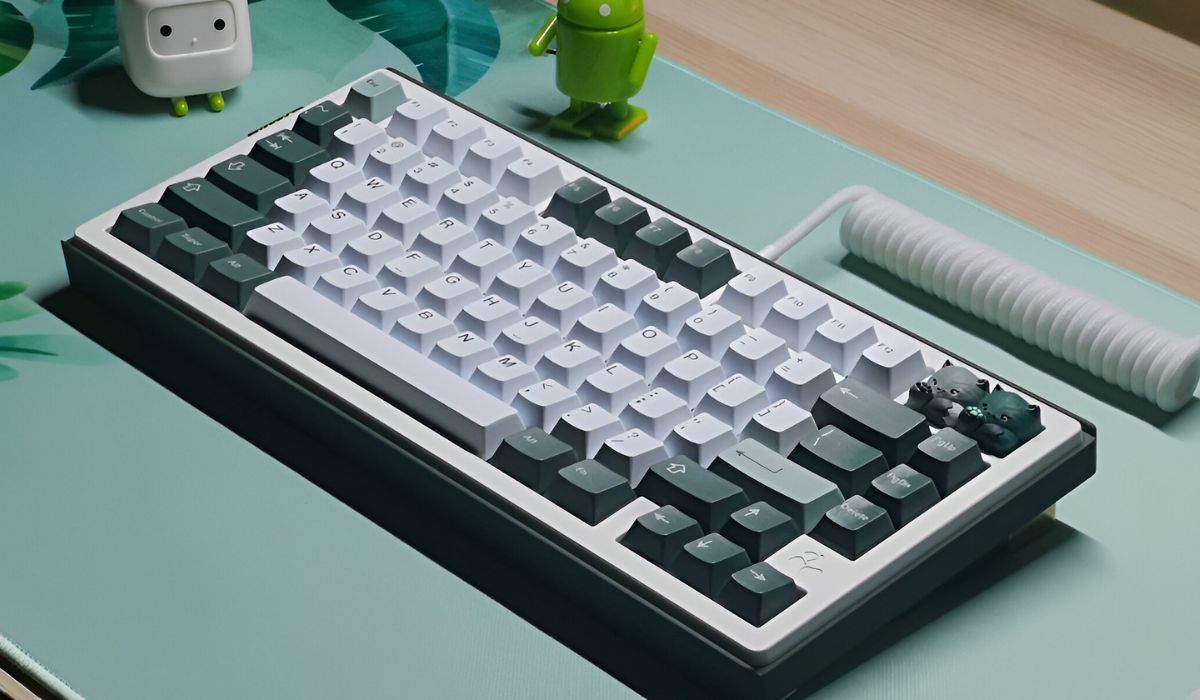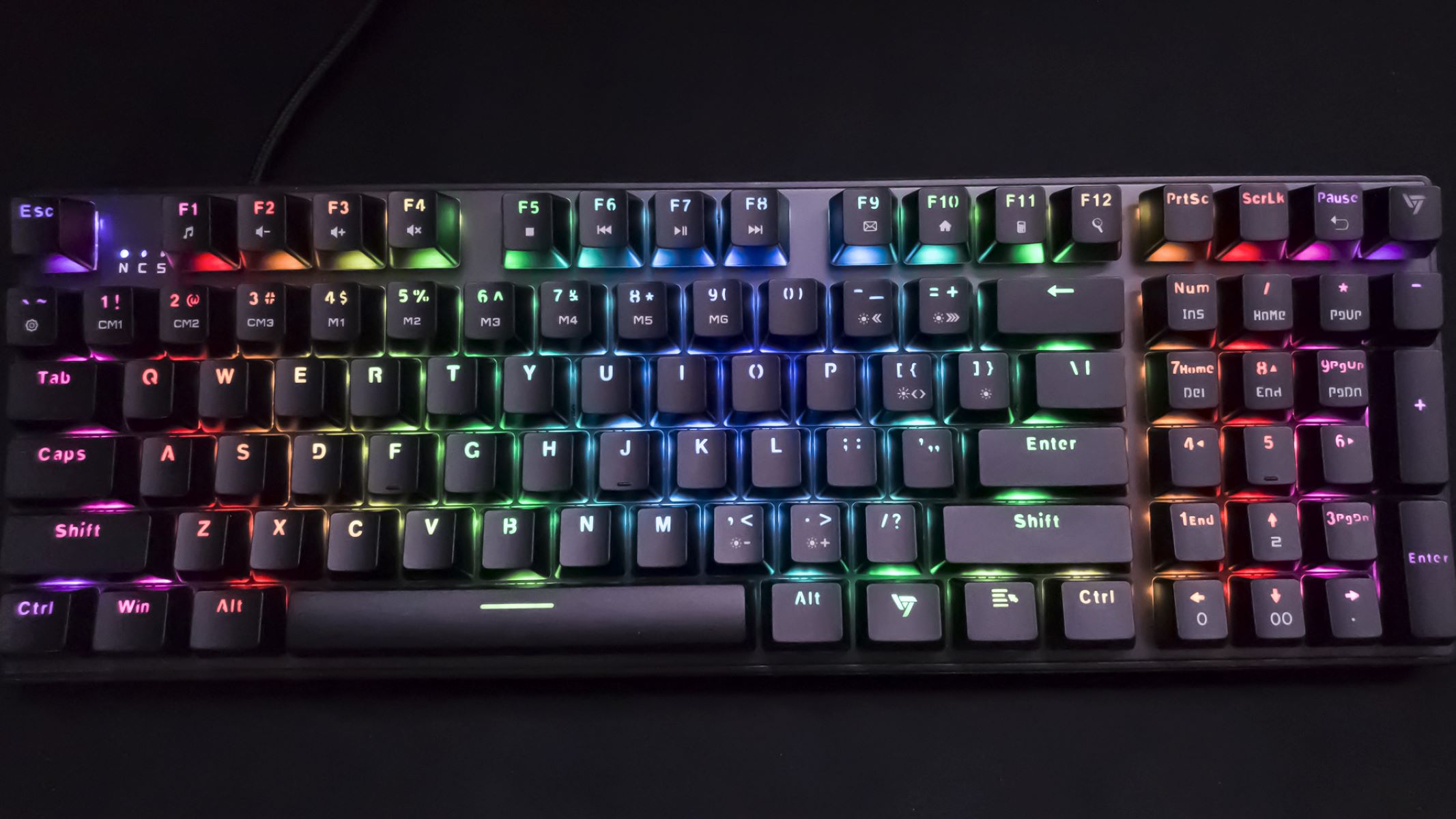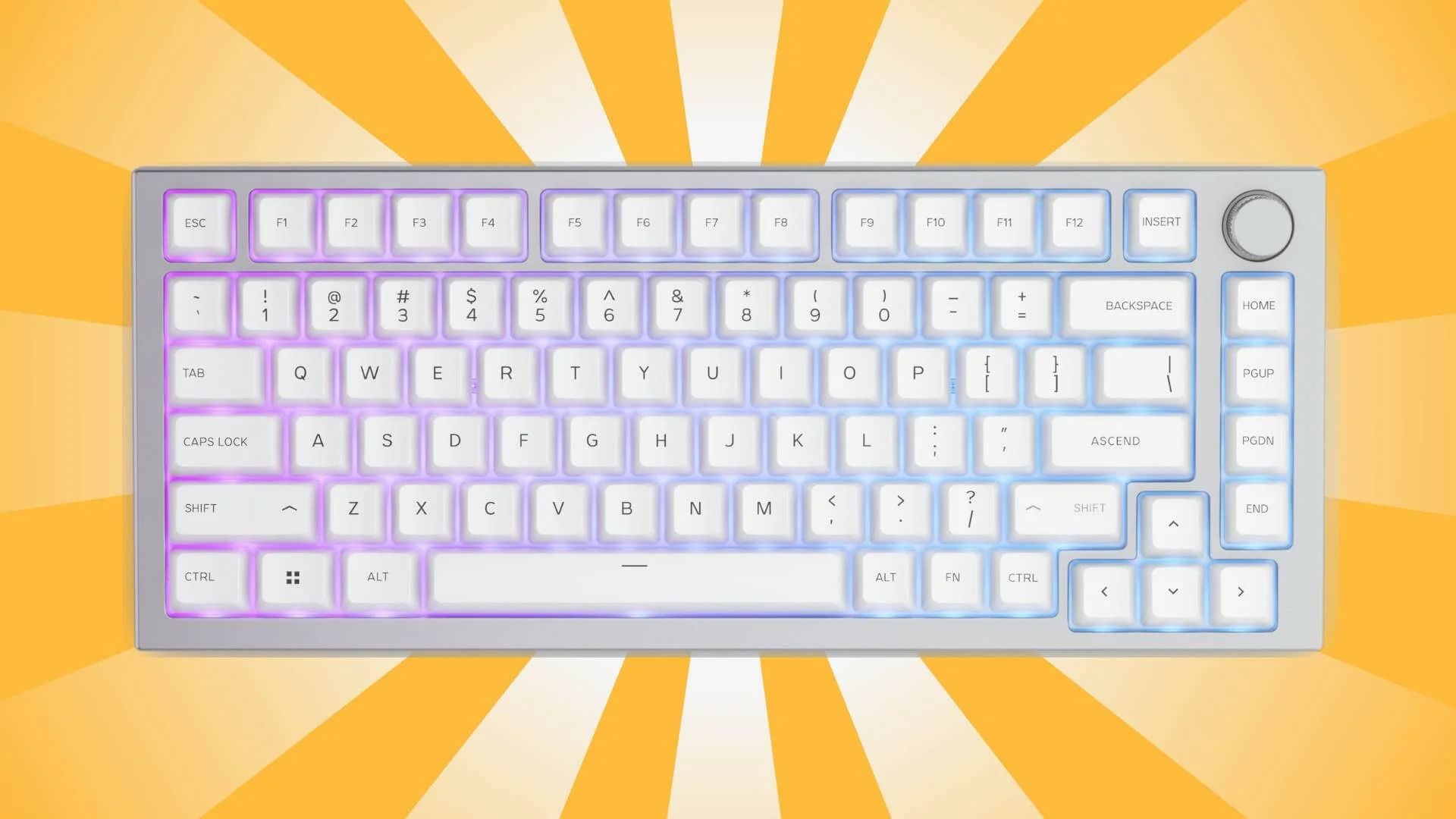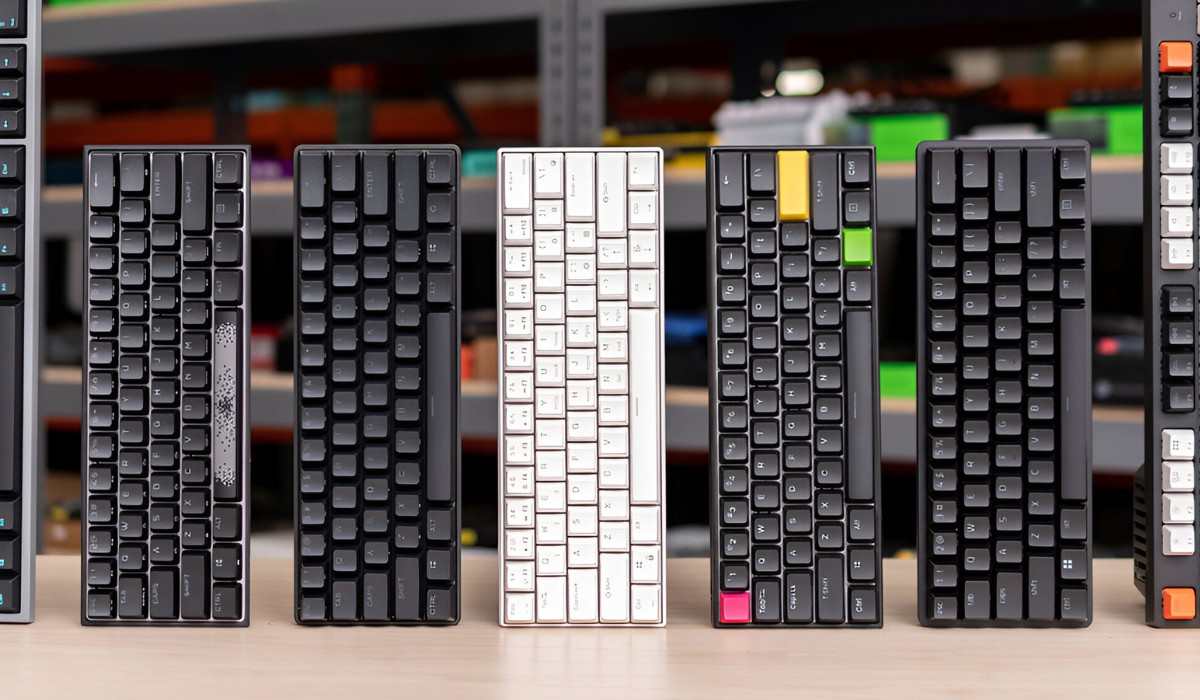Introduction
A full-size keyboard is a fundamental tool for typing and navigating on a computer. It is the primary input device that allows users to communicate with their machines effectively. Whether you’re a professional writer, a programmer, or a casual internet user, having a full-size keyboard can significantly enhance your productivity and overall user experience.
With the evolution of technology, keyboards have undergone various changes and modifications. They come in different layouts and sizes, but a full-size keyboard typically refers to the standard layout commonly used in desktop computers. It features a comprehensive set of keys that provide users with essential functions and shortcuts to perform various tasks.
In this article, we will explore the different types of keys found on a full-size keyboard and their respective purposes. We will delve into the alphanumeric keys, function keys, modifier keys, navigation keys, numeric keypad, arrow keys, editing keys, multimedia keys, and programmable keys. Understanding these key types will help you maximize your productivity and streamline your workflow.
Whether you’re a seasoned computer user or a beginner, this article is designed to provide you with a comprehensive understanding of the keys found on a full-size keyboard. So, let’s dive in!
Standard Layout
The standard layout of a full-size keyboard typically consists of a set of alphanumeric keys, function keys, modifier keys, navigation keys, numeric keypad, arrow keys, editing keys, multimedia keys, and programmable keys. This layout is designed to provide users with a balanced and efficient typing experience.
The alphanumeric keys are the primary keys on a full-size keyboard. They include the letters A-Z, the numbers 0-9, and various punctuation marks. These keys are arranged in a QWERTY layout, named after the first six characters on the top row of the keyboard. The QWERTY layout is the most widely used keyboard layout, and it is optimized for typing efficiency and reducing finger movement.
The function keys, typically located at the top row of the keyboard, are labeled as F1 to F12. These keys are versatile and can be programmed to perform different functions depending on the software being used. They often serve as shortcuts for executing specific commands or accessing various features within applications.
Modifier keys, such as Shift, Control, Alt, and the Windows or Command key, are essential for modifying the behavior of other keys. Pressing the Shift key, for example, allows you to type uppercase letters or access additional characters on the same key. The Control and Alt keys are often used in combination with other keys to trigger keyboard shortcuts.
The navigation keys, including the arrow keys and the Page Up, Page Down, Home, and End keys, facilitate the movement within documents or webpages. These keys come in handy when navigating through text, spreadsheets, or websites, allowing for precise cursor control and scrolling.
The numeric keypad, located on the right side of the keyboard, resembles a calculator layout and is used primarily for numeric input. It includes numbers, mathematical operators, and additional function keys like Enter and Clear. The numeric keypad is particularly useful for entering large amounts of numerical data or performing calculations quickly.
The arrow keys, located in an inverted T shape, provide directional control. They allow you to move the cursor up, down, left, or right within documents or text editors. The arrow keys are also commonly used in games to navigate characters or objects in different directions.
The editing keys, such as Delete, Insert, Backspace, and Enter, facilitate text editing and manipulation. These keys allow you to delete characters, insert new lines, navigate through text, and confirm inputs. They are essential for efficient and accurate editing tasks.
The multimedia keys, often found on multimedia or gaming-oriented keyboards, provide quick access to media controls. These keys allow you to control audio playback, adjust volume levels, play, pause, or skip tracks, and even launch specific multimedia applications.
Lastly, some full-size keyboards may include programmable keys that can be customized to perform specific actions or macros. These keys are beneficial for individuals who require frequent access to certain commands or repetitive tasks. By assigning macros to these keys, users can automate complex sequences of actions with a single keystroke.
In this section, we have explored the standard layout of a full-size keyboard. The next sections will delve into the specific types of keys mentioned earlier, providing a deeper understanding of their functions and applications.
Alphanumeric Keys
The alphanumeric keys are the core keys on a full-size keyboard and include the letters A-Z, the numbers 0-9, and various punctuation marks. They are arranged in a QWERTY layout, named after the first six characters on the top row of the keyboard.
These keys are the primary means of inputting text and are used extensively for typing documents, creating emails, coding, and more. The QWERTY layout is designed to optimize typing efficiency and reduce finger movement by placing commonly used letters in easily accessible positions.
Each alphanumeric key serves a unique purpose. The letter keys are used for typing any alphabetic character, while the number keys allow you to input numerical values. The punctuation marks, such as commas, periods, question marks, and exclamation marks, are used to punctuate sentences and aid in clarity and understanding.
Typing on a full-size keyboard is a skill that improves with practice. Touch typists, for example, can effortlessly type without looking at the keys, relying on their muscle memory and the tactile feedback of the keys. This skill greatly enhances typing speed and accuracy, making it an essential skill for professionals who spend a significant amount of time on their computers.
Many full-size keyboards also feature additional keys that provide quick access to common functions. These keys may include special characters or symbols, media control keys, application shortcuts, and more. These extra keys can be highly useful for specific tasks or software applications, allowing users to streamline their workflow and navigate their computers more efficiently.
When typing on a full-size keyboard, it is important to maintain a comfortable and ergonomic posture. Proper hand and wrist positioning can prevent strain and injury, especially during extended typing sessions. Using a wrist pad or adjusting the height and angle of the keyboard can help maintain a natural and comfortable typing position.
Overall, the alphanumeric keys are the core components of a full-size keyboard, allowing users to input text, numbers, and symbols efficiently. Understanding the QWERTY layout and becoming familiar with touch typing techniques can greatly enhance productivity and overall typing experience.
In the next section, we will explore the various functions and applications of the function keys found on a full-size keyboard.
Function Keys
Function keys, typically located at the top row of a full-size keyboard, are labeled as F1 to F12. These keys serve various functions and can be programmed to perform different actions depending on the software being used.
Function keys are versatile and can act as shortcuts to execute specific commands or access various features within applications. The specific functions of the function keys may vary depending on the operating system and the software being used.
Here are some common uses of function keys:
- F1: The F1 key is often used as a help key. Pressing F1 within an application or software can bring up context-sensitive help or open a help menu.
- F2: The F2 key is commonly used for renaming files or folders. When a file or folder is selected, pressing F2 allows you to edit the name directly.
- F3: The F3 key is often used to trigger a search function within a document or file explorer. Pressing F3 can bring up a search box to find specific words or phrases.
- F4: The F4 key has various uses depending on the context. In some applications, it may open a dropdown menu or display a list of recently used commands.
- F5: The F5 key is commonly used to refresh or reload a webpage or document. Pressing F5 can update the content to reflect any changes or updates.
- F6: The F6 key can have different functions depending on the software being used. In web browsers, it often focuses on the address bar or the search field.
- F7: The F7 key is frequently used for spell checking in word processors or text editors. Pressing F7 can scan the document for spelling errors and suggest corrections.
- F8: The F8 key is typically associated with booting options in Windows. Pressing F8 during startup brings up the Advanced Boot Options menu.
- F9: The F9 key’s function can vary depending on the software. In some applications, it can refresh the content or perform specific tasks assigned by the user.
- F10: The F10 key is often used to activate the menu bar of an application. Pressing F10 can bring up the menu options, allowing for easy navigation and access to different functions.
- F11: The F11 key is commonly used to toggle between fullscreen and windowed modes. Pressing F11 can expand the application or web browser to fill the entire screen.
- F12: The F12 key has diverse functions depending on the context. In many applications, it can open the Save As dialog box to save a document or view additional settings.
While these are some common uses of the function keys, it is essential to note that their functions can be customized within certain software or applications to suit individual preferences and workflow requirements.
Understanding the functions of the function keys and how they can be personalized can significantly enhance productivity and efficiency when working with different software or performing specific tasks.
In the next section, we will explore the modifier keys, which play a crucial role in enhancing the functionality of other keys on a full-size keyboard.
Modifier Keys
Modifier keys are an integral part of a full-size keyboard and play a crucial role in enhancing the functionality of other keys. These keys, including Shift, Control (Ctrl), Alt, and the Windows or Command key, allow users to modify the behavior of various functions and execute a wide range of keyboard shortcuts.
Here are the main modifier keys and their functions:
- Shift: The Shift key is used to type capital letters and access the secondary characters on a key, such as symbols and special characters. Holding down Shift while typing an alphanumeric key produces the uppercase version of that character.
- Control (Ctrl): The Control key, often labeled as Ctrl, is predominantly used in combination with other keys to trigger keyboard shortcuts. Common shortcuts include Ctrl+C for copy, Ctrl+V for paste, and Ctrl+Z for undo. The Ctrl key varies in functionality across different applications and operating systems.
- Alt: The Alt key, short for Alternate, is primarily used to access alternative characters or perform specific functions within applications. It is often employed in conjunction with other keys to invoke keyboard shortcuts or navigate through menus.
- Windows/Command key: The Windows key is found on keyboards designed for Windows-based systems, while the Command key is typically associated with Mac computers. These keys serve as shortcuts to various system functions, such as opening the Start menu (Windows) or launching Spotlight (Mac).
Modifier keys can be combined with other keys to create powerful keyboard shortcuts that speed up tasks and improve efficiency. For example, using Ctrl+C to copy selected text or Ctrl+P to print a document can save time and reduce the reliance on mouse clicks.
Additionally, modifier keys can be used in combination with function keys to access advanced system functions or perform specific actions within applications. For example, Ctrl+F4 (Windows) or Command+W (Mac) can close the current window or tab, while Ctrl+Alt+Delete (Windows) or Command+Option+Escape (Mac) can open the task manager or force quit applications.
These modifier keys provide users with greater control and flexibility, allowing for a more efficient and personalized computing experience. The specific functions and keyboard shortcuts may vary depending on the operating system, software, and user customization preferences.
Understanding how to use modifier keys effectively can greatly enhance your productivity and efficiency when working with a full-size keyboard. By mastering these keys and the associated shortcuts, you can streamline your workflow and navigate through applications more efficiently.
In the next section, we will explore the navigation keys and their role in facilitating cursor movement and document navigation on a full-size keyboard.
Navigation Keys
The navigation keys on a full-size keyboard play a crucial role in facilitating movement within documents, webpages, spreadsheets, and more. These keys allow users to navigate through text, make selections, and scroll through content with ease.
Here are the main navigation keys and their functions:
- Arrow keys: The arrow keys, arranged in an inverted T shape, allow users to move the cursor up, down, left, or right within documents or text editors. They provide precise control for navigating through lines, paragraphs, or cells in spreadsheets.
- Page Up and Page Down: The Page Up and Page Down keys allow users to scroll through content in larger increments. Pressing Page Up moves the view up by one page, while Page Down moves the view down by one page.
- Home and End: The Home key is used to quickly move the cursor to the beginning of a line or document, depending on the context. The End key, on the other hand, moves the cursor to the end of a line or document. These keys are particularly useful when working with lengthy documents or large blocks of text.
- Insert: The Insert key toggles between the insert mode and the overwrite mode. In insert mode, new characters are inserted at the cursor position, shifting the existing text to the right. In overwrite mode, new characters replace the existing text at the cursor position.
These navigation keys provide a versatile way to move and select text or navigate through different sections within documents or webpages. They are particularly useful when editing or reviewing content, allowing for precise cursor control and quick navigation between specific parts of a document.
Depending on the application or software being used, these navigation keys may have additional functions or be customized to suit specific workflows. For example, in web browsers, pressing the spacebar can scroll down the webpage, while holding Shift and pressing the spacebar can scroll up. Shortcuts like Ctrl+Home (Windows) or Command+Up arrow (Mac) can quickly move the cursor to the beginning of a document.
Understanding and utilizing the navigation keys efficiently can significantly enhance productivity and save time when working with extensive documents or navigating through content-rich websites. By becoming familiar with these keys and their functions, users can navigate and edit text with ease, improving overall typing and document navigation experience.
In the next section, we will explore the numeric keypad and its useful functions for numeric input and calculation tasks.
Numeric Keypad
The numeric keypad, typically located on the right side of a full-size keyboard, is a dedicated section designed for efficient numeric input and calculations. Resembling a calculator layout, the numeric keypad includes numbers, mathematical operators, and additional function keys.
The numeric keypad is invaluable for tasks that involve extensive numeric data entry, such as accounting, data input, and spreadsheet calculations. Here are the main components of the numeric keypad:
- Number keys: The numeric keypad provides a convenient layout of numbers from 0 to 9, allowing users to input numerical values quickly.
- Decimal point: The decimal point key (.) is used to input decimal numbers when working with financial calculations or numeric data that requires precision.
- Mathematical operators: The numeric keypad includes essential mathematical operators, such as addition (+), subtraction (-), multiplication (*), and division (/). These operators are useful for performing quick calculations without the need to reach for the main keyboard.
- Enter: The Enter key on the numeric keypad is used to confirm inputs or execute commands, similar to the Enter key located on the main section of the keyboard. It allows for seamless data entry and navigation through spreadsheet cells.
- Clear: The Clear key (often labeled as “C” or “Clear”) is used to delete or clear the input field, providing a quick way to remove any incorrect entries or start a new calculation.
- Function keys: Some full-size keyboards may feature additional function keys on the numeric keypad, such as the percent (%) key or the square root (√) key. These function keys provide shortcuts for specific calculations or advanced mathematical operations.
The numeric keypad is particularly advantageous for tasks that involve frequent numerical input, as it allows for faster and more accurate data entry compared to using the number keys at the top of the keyboard. Additionally, the placement and layout of the numeric keypad facilitate a more ergonomic hand position when working with numeric data.
It is important to note that laptops and compact keyboards often lack a dedicated numeric keypad due to size constraints. In these cases, the numeric keypad functions may be integrated into the main keyboard by using a combination of keys, usually by activating the Num Lock key.
Whether used for basic calculations or extensive numeric data entry, the numeric keypad offers a convenient and efficient solution for working with numbers. Mastering the use of the numeric keypad can significantly enhance productivity and streamline numeric-related tasks.
In the next section, we will explore the arrow keys and their role in providing directional control and navigation on a full-size keyboard.
Arrow Keys
The arrow keys on a full-size keyboard are four distinct keys arranged in an inverted T shape. They provide precise directional control and facilitate navigation within documents, text editors, spreadsheets, and more. The arrow keys play a critical role in moving the cursor or selection and offer a convenient way to navigate through content without the need for a mouse or touchpad.
Here’s a breakdown of the arrow keys and their functions:
- Up Arrow: The up arrow key moves the cursor or selection up one line at a time. It allows for precise control when navigating through text or making selections vertically.
- Down Arrow: The down arrow key moves the cursor or selection down one line at a time. Like the up arrow key, it provides precise vertical navigation within documents or text editors.
- Left Arrow: The left arrow key moves the cursor or selection to the left one character at a time. It enables accurate horizontal movement within text or cells in spreadsheets.
- Right Arrow: The right arrow key moves the cursor or selection to the right one character at a time. Like the left arrow key, it facilitates precise horizontal navigation within content.
The arrow keys are particularly useful in applications that require precise movement or selection, such as editing a document, navigating through code, or working with spreadsheet cells. They provide a level of control and accuracy that may be difficult to achieve using other navigation methods.
In addition to character-based movement, the arrow keys can also be used in combination with modifier keys to perform specific functions. For example, holding down the Shift key while pressing an arrow key allows for selecting text, extending the selection, or making a range selection in spreadsheets.
While the arrow keys primarily focus on cursor movement and selection, they can also be useful for scrolling through content in applications that support it. In some software, holding the Control (Ctrl) key while pressing an arrow key can initiate scrolling instead of moving the cursor or selection.
By mastering the use of the arrow keys, users can efficiently navigate through documents, make precise selections, and streamline their workflow. The arrow keys offer a reliable and efficient alternative to using the mouse or touchpad, providing a more keyboard-centric approach to navigating and editing content.
In the next section, we will explore the editing keys and their role in facilitating text manipulation and editing tasks on a full-size keyboard.
Editing Keys
The editing keys on a full-size keyboard are a set of keys dedicated to facilitating text manipulation and editing tasks. These keys allow users to delete, insert, navigate, and modify text efficiently within documents, text editors, and other applications. They are essential for precise editing and maintaining accuracy when working with written content.
Here are the primary editing keys and their functions:
- Delete: The Delete key is used to delete characters at or after the cursor’s current position. It is particularly useful for removing characters or content to the right of the cursor.
- Backspace: The Backspace key is used to delete characters before the cursor’s current position. It allows for precise deletion of characters or content to the left of the cursor.
- Insert: The Insert key is a toggle key that switches between insert mode and overwrite mode. In insert mode, new characters are inserted at the cursor’s position and push the existing text to the right. In overwrite mode, new characters replace the existing text at the cursor’s position.
- Enter: The Enter key is used to insert a new line or confirm an input, depending on the context. It signifies the end of a paragraph or executes commands within applications or dialog boxes.
- Home: The Home key moves the cursor to the beginning of a line or document, depending on the context. It allows for quick navigation and positioning when working with lengthy documents.
- End: The End key moves the cursor to the end of a line or document, depending on the context. It facilitates swift navigation and helps locate the last character or position within a document.
These editing keys, combined with other navigation and modifier keys, allow for precise text manipulation and editing tasks. By mastering these keys, users can efficiently delete characters or content, insert new lines, navigate through text, and maintain accuracy when making any necessary changes to written content.
Many software applications also support additional editing shortcuts that can be executed using a combination of keys. For example, pressing Ctrl (or Command on a Mac) along with the Backspace or Delete key allows for word-level deletion or movement, making it easier to edit large sections of text at once.
Moreover, text editors and word processors often provide a range of advanced editing commands and functionalities, such as find and replace, text formatting, indenting, and more. These can be accessed through menus or keyboard shortcuts, enhancing editing capabilities and streamlining tasks further.
By utilizing the editing keys and mastering the available editing shortcuts, users can efficiently work with written content, ensuring accuracy and maintaining a productive editing workflow.
In the next section, we will explore the multimedia keys and their role in providing quick access to media controls and enhancing the multimedia experience on a full-size keyboard.
Multimedia Keys
Multimedia keys, often found on full-size keyboards, provide quick access to media controls and enhance the multimedia experience for users. These keys allow for convenient management of audio and video playback, volume control, launching applications, and more.
Here are the primary multimedia keys commonly found on full-size keyboards:
- Play/Pause: The Play/Pause key allows users to play or pause the current audio or video playback. It provides a convenient way to control media playback without having to switch to the media player interface.
- Stop: The Stop key stops the current audio or video playback. It halts the media and returns it to the beginning if played again.
- Next Track/Previous Track: The Next Track and Previous Track keys allow users to skip to the next or previous track within a playlist or media library. They provide quick navigation through songs or videos without the need to interact with the media player directly.
- Volume Control: Volume control keys, usually represented by speaker icons, allow users to adjust the volume level of their audio output. The Volume Up and Volume Down keys increase or decrease the volume, while the Mute key instantly mutes or unmutes the audio.
- Media Launch/Hotkeys: Some full-size keyboards include multimedia hotkeys that allow users to launch specific multimedia applications or perform predefined actions with a single press. For example, there may be keys assigned to launch a music player, a web browser, or email client directly.
The multimedia keys provide a convenient and efficient way to control media playback and manage audio settings without the need to navigate through menus or use on-screen controls. They enhance the multimedia experience by offering quick and seamless access to media controls.
In addition to physical multimedia keys, many operating systems and media players also support keyboard shortcuts that can be used for media control. For example, combinations like Spacebar for play/pause, Ctrl+Right Arrow for next track, and Ctrl+Left Arrow for the previous track are often supported.
The functionality and configuration of multimedia keys may vary depending on the operating system, media player, or keyboard manufacturer. Users may have the ability to customize the multimedia keys or assign different actions to suit their specific preferences and software usage.
Integrating multimedia keys into a full-size keyboard enhances the convenience and user experience, providing quick and easy control over media playback and audio settings.
In the next section, we will explore the concept of programmable keys and their ability to be customized to perform specific actions or macros.
Programmable Keys
Programmable keys, often found on full-size keyboards, offer a unique level of customization and flexibility. These keys can be programmed by the user to perform specific actions or execute macros, providing a personalized and efficient workflow.
Programmable keys are typically extra keys located on the keyboard, separate from the standard layout. They can be assigned with various functions, such as launching applications, opening specific files or folders, performing complex sequences of commands, or even emulating keyboard shortcuts.
Here are the benefits and features of programmable keys:
- Customization: Programmable keys allow users to tailor their keyboard to their specific needs. They can assign frequently used commands, long key sequences, or repetitive tasks to a single key, saving time and effort in executing those actions.
- Streamlined Workflow: By creating macros and assigning them to programmable keys, users can perform complex actions with a single keystroke. This streamlines the workflow and increases productivity, especially for tasks that require multiple steps or repetitive actions.
- Application-Specific Settings: Programmable keys can be set to change their functions depending on the active application. This allows users to have different sets of key assignments for different software or switch between specific profiles tailored to different workflows.
- Multimedia Controls: Programmable keys can be programmed to control multimedia functions, such as play/pause, volume control, or skipping tracks. This brings the multimedia control directly to the keyboard and eliminates the need to switch applications or touch external media control devices.
The level of customization and programmability may vary depending on the keyboard model and accompanying software. Some keyboards provide dedicated software utilities that allow users to assign functions, macros, or key combinations to programmable keys easily.
Programmable keys can greatly enhance user productivity by eliminating repetitive tasks, reducing the reliance on mouse movements, and streamlining workflows. They provide a customized experience that caters to individual preferences and specific software requirements.
Whether you are a professional content creator, a software developer, or a power user who relies heavily on keyboard shortcuts, programmable keys offer a powerful tool for boosting efficiency and optimizing your workflow.
In the next section, we will conclude this article by summarizing the key points discussed and emphasizing the importance of a full-size keyboard for improved productivity and user experience.
Conclusion
A full-size keyboard is a fundamental tool that allows users to communicate effectively with their computers. It provides a wide range of keys, functions, and shortcuts that enhance productivity and streamline workflows.
In this article, we explored the different components of a full-size keyboard, including the alphanumeric keys, function keys, modifier keys, navigation keys, numeric keypad, arrow keys, editing keys, multimedia keys, and programmable keys. Each of these key types serves a specific purpose and facilitates various tasks.
The alphanumeric keys are the core keys used for typing text and inputting numbers, while the function keys provide shortcuts for specific commands and features in applications. The modifier keys enhance the functionality of other keys and allow for customized actions, while the navigation keys enable precise movement and selection within documents.
The numeric keypad is indispensable for numeric input and calculations, and the arrow keys provide directional control and navigation. The editing keys facilitate text manipulation and editing tasks, while the multimedia keys offer quick access to media controls and enhance the multimedia experience.
Lastly, the programmable keys provide a high level of customization, allowing users to program specific functions, macros, or application-specific settings to streamline their workflows and boost productivity.
Understanding and utilizing the different keys and functions on a full-size keyboard can significantly improve productivity, efficiency, and overall user experience. Whether you’re a professional writer, a programmer, or a casual computer user, mastering the features of a full-size keyboard can enhance your ability to communicate, create, and navigate with ease.
So, make the most of your full-size keyboard and explore its capabilities. Customize key settings to fit your unique needs, learn useful keyboard shortcuts, and practice efficient typing techniques. With a skillful command of your full-size keyboard, you’ll find yourself accomplishing tasks more swiftly, working seamlessly, and unlocking your full creative potential.







